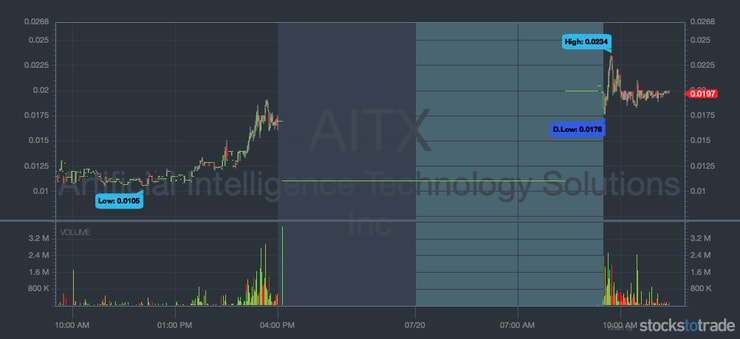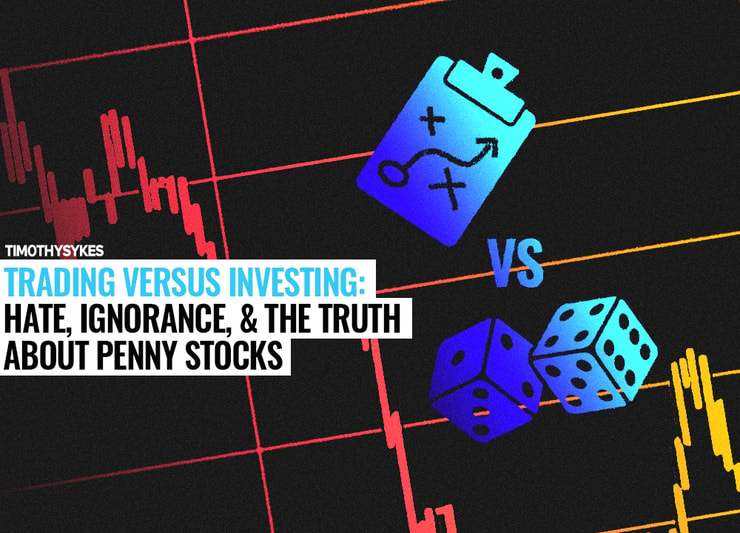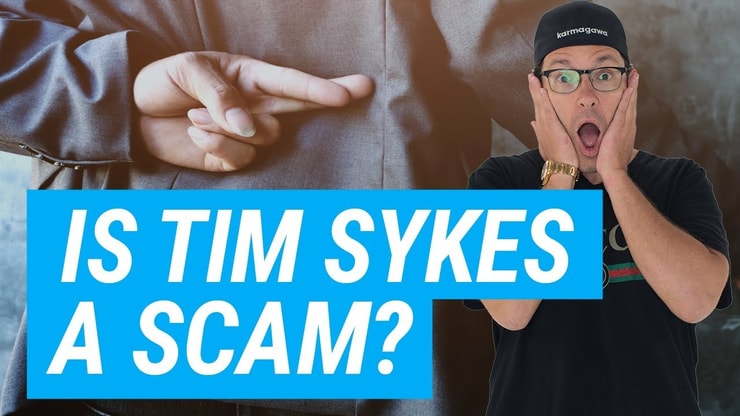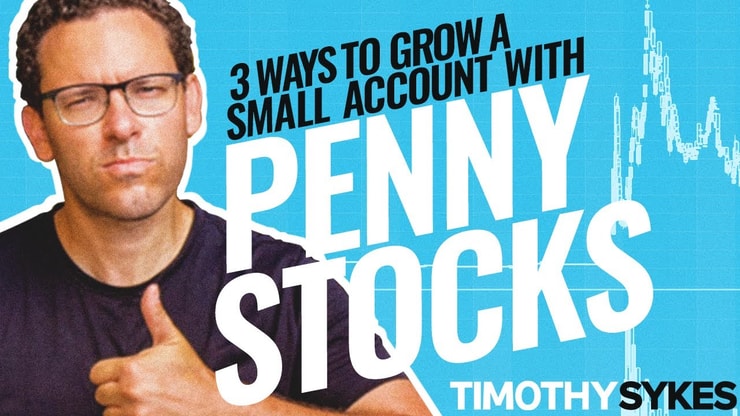Penny stocks can be a taboo subject … Especially because too many people don’t understand the difference between trading versus investing.
It makes people super uncomfortable … People don’t want to dig deeper. They just want to label penny stocks as bad news and move on.
It’s time to set the record straight.
I wanna talk about the hatred, controversy, and conflicting opinions surrounding penny stocks.
The general discomfort and distrust of penny stocks is evident in recent media articles blasting the surge of new traders interested in low-priced stocks as a dangerous phenomenon.
How do I feel about seeing my niche in the news like this?
On one hand, I’m thankful for articles like this. They keep the penny stock world from becoming oversaturated.
That helps my students and I maintain an edge.
But on the other hand, I’m all about transparency … So I’ve gotta speak up about what I think they got right, what they got wrong, and why it’s not penny stock trading that’s the problem — it’s having the wrong mindset.
It’s not understanding why the difference between trading versus investing is critical in penny stocks.
(*Please note: My trading results, along with the results of my top students are far from typical. Individual results will vary. Most traders lose money. My top students and I have the benefit of many years of hard work and dedication. Trading is inherently risky. Do your due diligence and never risk more than you can afford to lose.)
Table of Contents
Trading Versus Investing: Do Penny Stocks End in Tears?
A recent CNBC article about the speculative penny stock market really showcases the general hatred toward penny stocks.
It was written by Ron Insana, a financial reporter, analyst, and commentator. He was also the Managing Director of Insana Capital Partners. He definitely knows a thing or two about the stock market.
In the article, he talks about the dangers of trading penny stocks and why it’s “disturbing” that so many penny stocks have been running in this crazy volatile market.
He brings in some big financial names like Leon Cooperman and Howard Marks. They summarize their take that episodes like this “typically end in tears.”
I’ll admit — the market has been insane. That’s why I’ve created resources like my no-cost “Volatility Survival Guide” to help traders cope with the volatility and develop strategies that help them stay safe.
I also want to acknowledge that the article is clearly intended to protect newbies from the dangerous games that can go on in the world of low-priced stocks.
I think it’s great that he’s warning people about the dangers of penny stocks. Because they’re very real. Especially for newbies who don’t understand trading versus investing or what makes these stocks move or how pennystocking works.
Trouble is, it’s a very one-sided point of view. It doesn’t tell the full story. There’s a lot about penny stocks that people don’t talk about.
Penny Stock Villains
In the article, you’ll read about plenty of big, bad figures in the penny stock world.
Take Meyer Blinder, for example. He described himself as the “king of the penny stock market,” and eventually went to prison for racketeering and money laundering.
And we can’t forget good ol’ JB, aka “The Wolf of Wall Street” and the inspiration for the movie of the same name. He ended up bankrupt and in jail, too.
He also talks about the less visible villains — the pumpers on message boards and social media who build up stocks for self-serving purposes.
These villains are very real, and they highlight the darker side of penny stocks.
But here’s the thing: if you have the right strategy, these pumpers don’t matter. You can actually use their ridiculous schemes to your advantage.
I LOVE that promoters are really effective lately as it makes for VERY predictable charts like https://t.co/odGAkRPNNf & https://t.co/aICa7zhCLS since they got good coke in to do their jobs better than their mentor JB, but you must recognize pumps to trade them & not hold & hope!
— Timothy Sykes (@timothysykes) July 14, 2020
When it comes to penny stocks, it’s key that you learn trading versus investing. You learn to ride the momentum of stock spikes. But you must be able to recognize key patterns and know what to look for.
Trading Versus Investing: Looking at Penny Stocks Differently
As Insana acknowledges in the article, “we’ve seen reports of inexperienced investors opening up new brokerage accounts, with little guidance or education, while also being granted excessive credit with which to speculate in small stocks or fractional shares.”
Now we’re getting somewhere.
Penny stock pumps are very real. The market volatility is very real. Newbies blow up their accounts far too often.
These things can be very dangerous if you don’t take the time to learn how penny stocks work.
But what if you take the time to build your knowledge account and learn how penny stocks work?
I approach penny stocks differently. First, I don’t believe in these companies. And I don’t invest in these companies. I only take short-term positions. My goal is to make consistent gains from the brief spikes these stocks make before they typically fail. Yes, I know they’re going to fail.
It’s a different mindset, but it’s worked for me for 20+ years. There are ways to trade penny stocks — and manage risk — to grow a small account.
Are Penny Stocks a Scam?
It’s easy to see why so many people think that penny stocks are a total scam.
There are plenty of people who think I’m a fraud … until they really start to understand my process. And trading versus investing. Intelligently riding the momentum versus holding and hoping.
Michael Goode, my first millionaire student, started out thinking I was a scam. But I reached out to him, talked to him, and persuaded him to try my strategy. Now, he’s made over $2 million.*
I’m not a scam. I’m totally transparent. I’ll tell you everything…
It’s All About Your Mindset
If you get into penny stocks without knowing the difference between trading versus investing … If you don’t take the time to educate yourself … The risk of account devastation that the CNBC article warns about is very real.
But for SMART traders who study hard, learn key patterns, and develop a strategy, penny stocks can create a ton of different opportunities.
My top students are living proof. Recently several of them were featured in a New York Post article about penny stock trading. Don’t miss it!
Tim Grittani is a stellar example of both what can go right and wrong with penny stocks. He initially lost his first trading account … But that made him realize that he needed to learn how the market worked or he’d just lose it all again.
Armed with a second account of $1,500, he focused on learning. He kept a trading journal to track every trade. That’s how he analyzed what was working and what wasn’t.
He refined his strategies, and now he’s up over $12 million.* Now, he’s a mentor in his own right.
What did he do a few weeks ago when he made over $200K* in a single day of trading? He gave a webinar for my Trading Challenge students. (I even took notes — check out the top 15 lessons of Grittani’s webinar here.)
He’s dedicated not only to his trading but to helping others. So if you think that everyone involved in the world of penny stocks is a “Wolf of Wall Street” type — it’s just not true.
More Breaking News
- Baytex Energy Stock Rises Amid Strategic Partnerships and Financial Resilience
- BitMine Immersion Tech Sees Tremendous Stock Rally Amid Q3 Revenue Surge
- Why SoFi Stock is On the Rise
My Top Students Get It
I have plenty of students who are following in Grittani’s footsteps, too.
And I don’t mean that they’re following his trades. I mean that they’re spending the time to refine their top trading techniques and improving and scaling up over time. And they’re killing it. For example:
- Jack Kellogg is up over $690K.*
- Kyle Williams is up over $350K.*
- Matthew Monaco is up over $200K.*
Stephen Johnson is a great example of a trader who’s turned a corner in his education. He had a tough few years figuring out how to trade penny stocks. Look at his profit chart now. He’s found consistency … And he reports that he’s up over $30K.*
Trading Versus Investing: The Truth About Penny Stocks
What do I want you to know about penny stocks? Here are some key lessons…
Don’t Believe the Hype
You can’t believe that any penny stock is the next Microsoft or Google. Fraudsters and pumpers might want you to believe that, but it’s not true.
Most penny stocks will eventually fail. In spite of that, they can have massive spikes before that inevitable fate. It’s all about being ready to react. You learn to recognize the patterns these stocks follow and prepare to take advantage of them.
You Don’t Have to Go for Home Runs
A lot of people think they have to get in on a trade before the spike starts and hold out till the bitter end. No! This is the core of understanding the difference between trading versus investing.
Trading is about capturing the meat of the move, then moving on.
I’m all about reacting, not anticipating. I want to see a stock prove itself and live up to one of my favorite patterns before I trade.
Personally, I trade scared! And I frequently take profits too early, but I’d rather do that than hold on too long. I also cut losses quickly — that’s my absolute #1 rule.
Here’s an example of one of my recent trades. On July 17, I bought Artificial Intelligence (OTCPK: AITX) at $0.016 and sold at $0.0189. Check out the chart:

As I said in my exit comments, “I gotta exit this one as it hit my goal so I can focus on VYST, too many plays, LOL, good problem to have, congrats to longs on all these plays it’s literally insane.”
As you can see by the chart, if I’d held on longer, I could have made more. Am I crying about it? Nope. I know there will always be another play.
Smart Traders Know There Are Opportunities in Every Type of Market
Yeah, you can potentially profit when stocks go up … but if the market shifts, you can shift your strategy, too.
If there’s a crash like when the Bitcoin bubble or the weed bubble burst, you can go short.
If you’re cynical when going long and you’re ready to short when the market goes down, you can adapt your strategy and trade in any type of market.
Penny Stocks Aren’t the Problem
What do people actually disagree with when it comes to my strategies?
Is it a bad idea to…
- Short a first red day on a pump?
- Cut losses quickly?
- Buy a multi-week breakout with a catalyst and volume?
When it comes down to it, even traders who hate penny stocks don’t actually find fault with my strategy. Most haters don’t even know my rules. They don’t even take the time to understand penny stocks.
That’s why I started teaching. I recognized the general hate against this niche and realized that there was an opportunity for traders who were willing to learn the patterns.
Why? Because I truly believe that this is how traders without much money can potentially grow their accounts.
Penny Stocks: Misunderstood … But That’s a Good Thing
I appreciate that articles like this are trying to help new traders avoid losing money.
But there’s still a disconnect between the perception of penny stocks and how traders can actually use them to their advantage.
It’s like when I was coming out with my book, “An American Hedge Fund.” People thought I shouldn’t even write about penny stocks. For most people, it boils down to you can’t handle the truth, you know? But I still felt like it was important to reveal the truth.
And I still believe that and will continue being transparent.
I truly believe that penny stocks offer an opportunity unlike any other type of trading. But you need to go about it the right way.
It’s all about your approach with penny stocks — it’s the right mindset and healthy cynicism that helps my students and I thrive where other people are blind.
Do you get the difference between trading versus investing? Leave a comment saying “I have the right mindset!”








Leave a reply